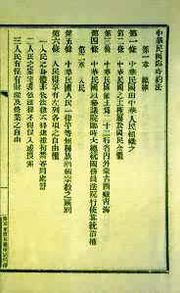
Provisional Constitution of the Republic of China
Encyclopedia

Xinhai Revolution
The Xinhai Revolution or Hsinhai Revolution, also known as Revolution of 1911 or the Chinese Revolution, was a revolution that overthrew China's last imperial dynasty, the Qing , and established the Republic of China...
, the Nanjing Provisional Government of the Republic of China
Republic of China (1912–1949)
In 1911, after over two thousand years of imperial rule, a republic was established in China and the monarchy overthrown by a group of revolutionaries. The Qing Dynasty, having just experienced a century of instability, suffered from both internal rebellion and foreign imperialism...
, led by Sun Yat-sen
Sun Yat-sen
Sun Yat-sen was a Chinese doctor, revolutionary and political leader. As the foremost pioneer of Nationalist China, Sun is frequently referred to as the "Father of the Nation" , a view agreed upon by both the People's Republic of China and the Republic of China...
, framed the Provisional Constitution of the Republic of China , which was an outline of basic regulations with the qualities of a formal constitution
Constitution
A constitution is a set of fundamental principles or established precedents according to which a state or other organization is governed. These rules together make up, i.e. constitute, what the entity is...
.
On March 11, 1912, it replaced the previous organizational outline of the government and was in effect as the supreme law. It was later replaced by a constitutional compact instituted by Yuan Shikai
Yuan Shikai
Yuan Shikai was an important Chinese general and politician famous for his influence during the late Qing Dynasty, his role in the events leading up to the abdication of the last Qing Emperor of China, his autocratic rule as the second President of the Republic of China , and his short-lived...
. However, it was restored once again on June 29, 1916, by President
President of the Republic of China
The President of the Republic of China is the head of state and commander-in-chief of the Republic of China . The Republic of China was founded on January 1, 1912, to govern all of China...
Li Yuanhong
Li Yuanhong
Li Yuanhong was a Chinese general and political figure during the Qing dynasty and the republican era. He was twice president of the Republic of China.- Early history :...
.
The Constitutional Protection Movement launched by the Military Government of the Republic of China in Guangzhou on September 10, 1917, was intended to "protect" this provisional constitution. In Beiyang Government
Beiyang Government
The Beiyang government or warlord government collectively refers to a series of military regimes that ruled from Beijing from 1912 to 1928 at Zhongnanhai. It was internationally recognized as the legitimate Government of the Republic of China. The name comes from the Beiyang Army which dominated...
, this provisional constitution was replaced by Cao Kun
Cao Kun
|-...
's constitution on October 10, 1923. In the Nanjing Government, this constitution was not replaced until June 1, 1931, when the Provisional Constitution of the Political Tutelage Period was announced, although the old constitution was already rarely discussed after the establishment of the Nationalist Government on July 1, 1925. From 1928 onwards, the Nationalists were operating under an Organic Law
Organic law
An organic or fundamental law is a law or system of laws which forms the foundation of a government, corporation or other organization's body of rules. A constitution is a particular form of organic law for a sovereign state....
that had an ambiguous relationship with the 1931 Provisional Constitution as it was not completely superseded.
Outline
- The government system was to imitate the FrenchFranceThe French Republic , The French Republic , The French Republic , (commonly known as France , is a unitary semi-presidential republic in Western Europe with several overseas territories and islands located on other continents and in the Indian, Pacific, and Atlantic oceans. Metropolitan France...
presidential cabinet: the SenateSenateA senate is a deliberative assembly, often the upper house or chamber of a legislature or parliament. There have been many such bodies in history, since senate means the assembly of the eldest and wiser members of the society and ruling class...
at the time wanted to restrain Yuan Shikai's ambitions, and they changed the presidential systemPresidential systemA presidential system is a system of government where an executive branch exists and presides separately from the legislature, to which it is not responsible and which cannot, in normal circumstances, dismiss it....
to a parliamentary systemParliamentary systemA parliamentary system is a system of government in which the ministers of the executive branch get their democratic legitimacy from the legislature and are accountable to that body, such that the executive and legislative branches are intertwined....
so that Yuan would be turned into a figurehead. - The general principles were to be outlined concisely, regulating the fundamental elements of the nation in principle.
- The presidential election would still be held in the Senate according to the organizational outline of the provisional Government.
- The JudiciaryJudiciaryThe judiciary is the system of courts that interprets and applies the law in the name of the state. The judiciary also provides a mechanism for the resolution of disputes...
system was completely independent, which matched the principle of separation of powersSeparation of powersThe separation of powers, often imprecisely used interchangeably with the trias politica principle, is a model for the governance of a state. The model was first developed in ancient Greece and came into widespread use by the Roman Republic as part of the unmodified Constitution of the Roman Republic...
: the provisional Constitution regulated that the provisional president and the Minister of the Judiciary would appoint judges separately. Trials were to be administered by judges independently without the intervention of the government.

